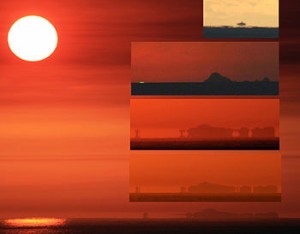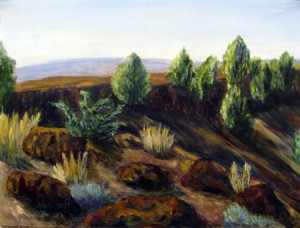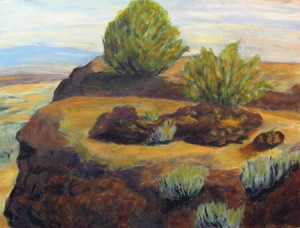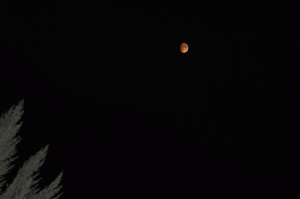The upper frame is an inferior mirage of the Farallon Islands. The second frame is the Farallon Islands with a green flash on the left-hand side. The two lower frames and the main frame are superior mirages of the Farallon Islands. The superior mirage went from a 3-image mirage (inverted image between erect ones) to a 5-image mirage to 2-image mirage. Such a display is consistent with a Fata Morgana. All frames but the upper one were photographed from about 50–70 feet above sea level. The upper frame was photographed from sea level. The interval between the first and last frames of the superior mirage was six minutes.
from “Mirage” in Wikipedia
And, on a not unrelated subject (albeit obscure, perhaps) I have finished my southeast Oregon painting extravaganza. It resulted in seven panels, each 16″ wide and 12 ” high, a total of 112″ in width (with no spacing) and 12″ in height: 9.25 feet x 1 foot.
[You can see individual panels as well as closer combos by checking southeastmain, a blog I maintain with husband Jer: From the Diamond Grade, panels 1 & 2, and the following four posts are the pertinent material. I’m not bothering to reproduce the results here because many of you already saw them, ad infinitum, on southeastmain.]
I am relatively pleased with the results of the 3 day marathon of painting the 112 inches of masonite panels. It gave me some insights I needed and a head start on a new project I’m preparing for my month back in the Mojave Desert, at Beatty Nevada (another residency at the Goldwell Open Air Museum).
However, the panorama is pleasing in great part because it looks pretty much what we would expect to see. It’s true that I tried to paint 180 degrees of sight, flattened to a line, which means that when faced with the real (not electronic) panels, you have to walk along the line to see it well; you can back up to take it in, but then much of the detail is lost. (The thought just occurred to me that there might be an optimal place to stand, where the edges of the painting are just beyond the normal peripheral range of vision — I could put some masking tape on the floor and require visitors to view it only along that line <snort>).
It’s also true that I tried to capture the change of time within the panorama, so unlike a single panoramic photograph, the painting starts in the early AM (about 6:30 AM, just after sunrise) and moves through about 5:30 PM, (early evening, when the sun at that particular date and latitude starts to lengthen to provide evening shadows.)
So I tried to go somewhat beyond a camera’s eye view of the scene, and even beyond a single plein air painting. The painting was done plein air, but over a period of days and different times of day.
However, it’s a pretty tame bit of visual art.
So I’m back to thinking about painting the void that is the desert and exploring visual perception, with all the usual suspects, Downes, Hockney, the Oakley Twins, Robert Irwin, in mind. And along the way, I ran across an article on mirages on Gabriola Island, in the Georgia Sound, off the British Columbia Island of Vancouver. And that led me to Wikipedia on mirages, whose image and caption I started this post with.
Mirages are caused by light passing through different zones of heat (Wikipedia has a good explanation). Mirages can be “inferior” — images that appear below the horizon, like lakes in the desert; or “superior” — images that appear above the horizon (see the caption on the opening photograph from Wikipedia). Objects beyond the “normal” sight of humans, beyond the horizon, can often hove into view, appearing sometimes with moving people within recognizable structures, all of which are not normally within view. These views are transient, often appear near sunset and disappear within an hour or so. They are able to be documented with a camera, since they are phenomena of light.
Thinking about mirages, then, led me to thinking about other optical phenomenon, such as the Moon Illusion — the way the moon will often look huge as it rises, becoming less and less large and luminous until it finally becomes just the regular moon in the upper sky. Donald Simanek in the Moon Illusion: an Unsolved Mystery explores a variety of speculations by scientists about this “irrational” view. [Wikipedia also has an article on the illusion, a bit easier to read and with much the same conclusion as Simanek arrives at. The article contains warnings about lack of references, however, and also feels a bit oversimplified after reading Simanek]. The Moon Illusion appears all over the world to all peoples, somewhat more to children than to adults, and, unlike mirages, which can be captured by camera, the moon illusion is uncapturable by camera or external devices. That means it’s a universal but internal-to-the-individual human perception.
Simanek goes into great detail to discuss the possible reasons for this, but what caught my attention was his discussion of the illusion of space, size, and distances, particularly distances to the horizon. When I’m thinking about the desert and its phenomena, mirage and distance play a large part of my thinking. Some of these perceptual anomalies are so familiar that it’s startling to realize how strange they are. For example, Simenak points out that at great distances, clouds will appear to be right on the horizon, at the earth, even when they are, generally speaking, some great distance above it.
These facts illustrate that when we are dealing with these great distances, our usual geometric logic about distances is essentially useless to describe what we perceive. Once this fact of perception is realized, one also realizes that many of the experiments and theories of the moon and sky illusions and many of the published papers on the subject of visual illusions are simply irrelevant to our judgments of very distant objects. [all indented quotes from Simanek]
Simanek discusses anisotropy, which in defined in Wikipedia: “Anisotropy (pronounced with stress on the fourth syllable: /?æna??s?tr?pi/) is the property of being directionally dependent, as opposed to isotropy, which means homogeneity in all directions. It can be defined as a difference in a physical property (absorbence, refractive index, density, etc.) for some material when measured along different axes. An example is the light coming through a polarizing lens” a lens such as the eye.
Simanek’s example of the brain’s correction of the way space and line actually are formed in our eyes when looking at straight lines helps understand why a trained visual artist might override the brain’s corrections and see “correctly” — as Hockney and Downes claim to do. However, Simanek does not claim that anisotropy is necessarily a function of the curved lens of the eyes;
I’m simply pointing out that the brain has mechanisms for dealing with the retinal shape, and the dynamically changing retinal image (as the eyes scan a scene), to produce a stable, and reasonably consistent geometry of visual space. This is what psychologists call “perceptual space”.
The larger visual space.
Spherical perspective of parallel lines
perceived from wide-ranging sweeping of the eyes
over more than a whole hemisphere.
This is similar to a fish-eye lens photograph.
Z (zenith), N (nadir), V (left and right vanishing points).
The insets show how parallel lines are
rectified as straight in the smaller visual field.Only when we scan our eyes around this geometric world, consciously trying to get the “bigger picture”, do we become aware how our eye/brain mechanism handles this problem. Try this experiment. Look at a long straight wall. The wall seems to have straight and parallel lines when our line of sight is perpendicular to the wall. But when looking parallel to the wall, those same lines appear to be straight lines converging to a “vanishing point” on the horizon. Shifting our gaze from one end of the wall to the other we integrate all of these views and finally perceive that those parallel lines appear as curved lines diverging from a point at the horizon, becoming nearly parallel, then converging to a point at the other horizon. This is the geometric world of our wider visual field, one of curved lines, a “Remannian” space. But when we fix our gaze in one direction, our brain straightens out those curves, producing a result like the “Euclidean” space of an artist’s strict perspective rendering.
This process does not, however, consistently “correct” angles between lines. Right angles in a perspective drawing are usually not right angles on the paper or canvas. Nor are angles correctly perceived by the eye when the plane of the angle is tilted with respect to our line of sight.
Once we recognize that visual space may not be anisotropic, and that it is a somewhat consistent distortion of real space, we have a new way of thinking about the moon illusion and related sky illusions.
I have quoted Simanek at length because I’m not sure I could get it right if I tried to paraphrase him. But his article has much more meat in it than anything I’ve covered here. For example, his section following the “Anisotropy” has some very clear indications that could be of interest to artists:
Space-filling
The research clearly indicates that nearby objects in the field of view do influence our judgment of the distance and size of more distant objects. In a general way, it seems that
- Objects in the visual field that are contiguous to the distant objects have the greatest effect on size judgments of distant objects.
- When there are many objects in the field of view for which we can readily and unambiguously assign sizes and distances, this can give a stronger impression of greater distance for those objects “beyond” the others, with weaker distance cues.
- When there are few contiguous objects and few strongly located nearer objects in the field of view, distant objects appear nearer than when the the distances of foreground objects distances are firmly determinable.
- We tend to perceive an object with fewer distance cues to be “just beyond” the farthest object for which we have mentally assigned a concrete “distance”.
- Easily recognized objects, and those for which distance cues are strong, are probably processed by the brain first, leaving more ambiguous objects for later processing. Of course the whole process is so rapid we think that the judgments are instantaneous.
It’s as if our visual space becomes “filled” with objects for which our brain can readily assign distances, leaving those with fewer (or ambiguous) distance cues to occupy the “more distant” space, located just beyond the more confidently located objects. Even within the visual space of relatively unambiguous distances and sizes, our brain has placed objects in this space by resolving visual conflicts and by using some visual cues to modify and reinforce other cues.
The moon illusion is consistent with what would be expected from evolutionary considerations. We have evolved cognitive processes that provide high quality visual information from nearby things, and things on our level that we can walk to and experience from various angles. These are all important to survival. Things seen high above, in the sky, or even those seen below, as when looking over the edge of a cliff, are less important. Therefore distance discrimination and detailed judgment of other visual properties of overhead objects is compromised.
I won’t continue with Simanek’s views of stereoptical views and more, for fear of violating his “fair use” rights. But in thinking about depicting the desert, as it could be perceived before our brain assigns its usual conformities, makes me pace about the room. “Things seen high above, or even those seen below” — what would the discriminating artist see that wouldn’t conform to mere haze and diminishment of size.
How does the moon look, rising over the Mojave Desert?
Photo by Jerry Underwood, of a rising moon, but alas, not noticeably anisotropic.






Hi June,
Of the many ideas that you presented, I am now first thinking about
.
I am impressed by your plein air paintings. I hope that, by next summer, I will have enough expertise to hike to my holy spot with enough equipment and protection (from sun and wind) to paint as well.
Thanks, Birgit,
Once you’ve gotten your plein air equipment organized and painted outside once or twice, you might get hooked on it. I’ve been painting from a photograph (to practice on a big canvas) and find the lack of information really annoying. I have enough memory to fill in some details, but the real thing is always so much better than any photo or memory can be for me. And I love being outside, even when the wind and bugs and heat are seriously irritating. It somehow feels just right.
As for the post, I feel a bit abashed that I didn’t get the information more clearly assimilated into my own thinking before posting. But it seemed like the weekend might be a good time for others to maunder through it, so I posted anyway. The ideas are complicated — the diagram on perspectives sent me into a dither — but I’m hoping they will help me see better. Not that seeing better means I’ll paint better — but hope springs eternal, regardless.
Thanks again for the comment. Don’t labor too hard on Labor Day.
June,
As an associative thinker, you are leading us to lots of interesting ideas. Please keep it up. Your ideas are helping me with feeling into the very next picture that I will paint. My painting will be based on a photograph and my intense experiencing of that photographed spot last weekend.
June,
Last night, I viewed the moon illusion, a full, orange moon rising up above the firs. On my photograph, it looked tiny.
Does this mean that most of my perceptions are mind tricks? Does it mean that the wonderful 3-D images of the dunes that I perceive are illusions of my mind and that my camera reproduces what is really out there?
Do I do injustice to the photographic process by complaining that the bluff on the lake shore looks so much smaller in wide angle photographs than it appears in my own vision?
This thought propelled me this morning to go out there and sketch the bluff. But I could not get myself to do it. The first hindrance were the enticing clouds. I meandered around, photographing from different perspectives, capturing the clouds, the creek, the bluff, the waves. By the time I was done, it was hot. The sun was high on the sky and the beach people arrived.
As a child at the North Sea, after a cloudy winter, I adored the sun and I was even thinking of praying to an Egyptian sun god. But I managed to get a sunstroke which may have sensitized me to too much sun exposure.
Because of my sun handicap, I am now trying to figure how to do 3-D paintings without sitting out there in the sun. One way may be to take photos from wide angle to telephoto and make montages to accumulate references. But the real trick will be to close my eyes and visualize that the dunes are rising all around me and then draw what I feel. This means, that I have to start drawing.
Birgit,
There’s always the big plein air umbrella that some people use to block the sun. I’m such a bad engineer (and navigator) that I never have tried it — I would not only lose it in the wind, but the sun would move in precisely the opposite direction as I expected. I do have an enormous sun hat from an outfit called something like Sunday Afternoon.
But drawing might be better, if you can keep from getting distracted. And working from memory and imagination can sometimes be extremely rewarding and sometimes more “true.”
As for the “illusions” (“truths”) — well, I like to think of our eyes and minds and cameras as resulting in different kinds of maps. The camera is like a road atlas; it isn’t a topographic map; which is different from those colorized Google satellite photos which are also maps. Maps of ocean currents are different from close-to-shore navigational maps which differ from maps of tourist sights. And some journal writers make personal maps with little sketches of where they’ve been, where the scale is determined by the “largeness” of the experience. If you were to make maps of your street, they might contain, perhaps, the best stoop for sitting on and chatting, the importance of the bus stop shelter, a storm grate that exudes ill smells — that would be a “true” but different kind of map than would exist elsewhere.
So these “illusions” which are not hallucinations, but forms of perception shared by most people, are real, true, and authentic. The road atlas is real, true, and authentic (until they change the roads) but it doesn’t encompass much of what is really present.
I myself am quite happy to discover there are different ways of seeing that are authentic, and that I’m not limited to the snapshots of the Brownie camera — or even the Nikon D90.
Of course, I’m also a grazer, rather than a methodical careful eater. I pick up an idea here, a notion there, and thus my analysis is more like a journaled map than a surveyor’s gem. And that’s the last mixed metaphor for this day, I hope.
Thanks for the great conversation.